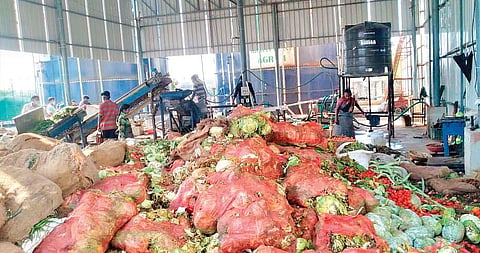Hyderabad's Bowenpally market's vegetable waste generates electricity, biofuel
HYDERABAD: Almost 10 tonnes of waste collected every day at the Bowenpally market, which was once worthless and would end up in landfills, is now adding meaning to people’s lives. More or less every ounce of the vegetable, fruit, and even flower waste collected at the market is now being used to generate around 500 units of electricity and 30 kg of biofuel. The electricity generated is used to light up over a 100 streetlights, 170 stalls, an administrative building and the water supply network. Meanwhile, the generated biofuel is pumped into the canteen kitchen of the market.
Calling it the ‘way ahead for a sustainable future’ Bowenpally selection grade secretary Lokini Srinivas said, “One would have never imagined that vegetable trash can be so valuable. This is the first initiative taken up by any vegetable market in the State to convert organic waste to electricity. We had started the project almost six months ago on a trial basis, which is now giving us very good results. For the bio-vegetable plant, we are using waste that is entirely generated here. We also collected vegetable waste from some nearby vegetable markets and supermarts. The Bowenpally market requires around 800-900 units of electricity on a daily basis, of which 500 units are now being generated from the waste management plant.”
How does it work?
To initiate the process of biomethanation, tonnes of vegetable waste is first put on conveyor belts that carry the waste to shredders. The shredded waste is then converted into a slurry and is put into large containers or pits to start the process of anaerobic digestion. Organic waste is eventually converted into biofuel, which has two major components, methane and carbon dioxide.
The fuel is then put into ‘100 per cent biogas generators’ that converts the fuel into electricity, and reaches the market’s electricity bulbs, explains Shruti Ahuja, director of Ahuja Engineering, the agency that is operating the plant for the Bowenpally market.
She added that apart from generating electricity and biofuel, the plant is also generating organic manure that can be used in farming. “The biggest benefactor here is the environment. Ten tonnes of waste which would have just piled up at some landfill is now generating biofuel and biomanure,” she says. This distributor-waste-management model is funded by the Department of Biotechnology and the Bowenpally Committee.

